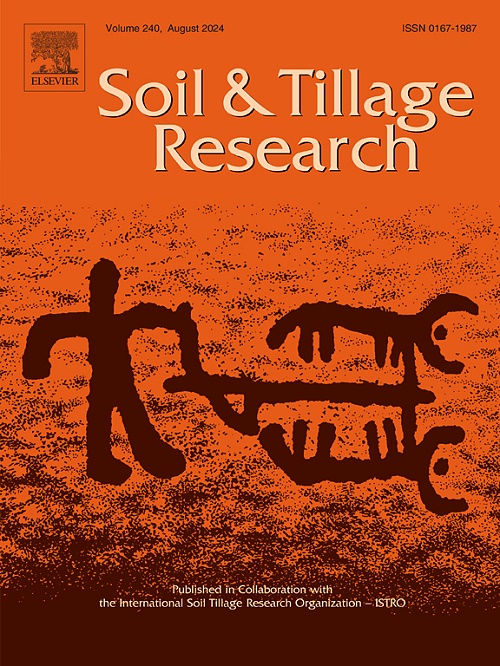长期有机无机施肥促进了水稻土颗粒有机质和矿物伴生有机质组分微生物坏死团碳的积累
IF 6.8
1区 农林科学
Q1 SOIL SCIENCE
引用次数: 0
摘要
微生物衍生化合物是土壤有机碳(SOC)的主要来源。然而,长期施肥调控酸性水稻土不同土壤深度微生物坏死团C (MNC)积累的驱动机制尚不清楚。本研究的目的是通过在12年的田间试验中检测土壤深度(0 −15 cm和15 −30 cm)中矿物相关有机质(MAOM)和颗粒有机质(POM)组分中的MNC含量来探索这一机制。4种处理分别为:不施肥(Control)、单施矿物肥(NPK)、氮磷钾与牛粪共施(NPKM)、氮磷钾与稻秆渣共施(NPKS)。与NPK相比,NPKM和NPKS分别提高了表层土壤有机碳28.1 %和20.6 %,POM-C含量分别提高了85.3% %和76.2% %。此外,与单独施用氮磷钾相比,施用氮磷钾的表层土壤和施用氮磷钾的下层土壤中,块状土壤中MNC含量分别提高了26 %和10.7 %。在所有施肥实践中,大多数MNC集中在MAOM组分上,真菌是散装土壤及其POM和MAOM组分中这种积累的主要贡献者。此外,与未施肥对照相比,NPKM和NPKS处理导致POM组内细菌坏死团C、真菌坏死团C和MNC(增加45-83 %)比MAOM组(增加8-36 %)增加更多。冗余分析和Mantel测试表明,有机碳库的组成与土壤养分水平以及矿物质属性(如Fep +Alp)之间存在显著相关性。PLS-PM结果表明,表层土壤中矿物质保存对MNC的影响显著,而底土中主要受土壤养分的影响。本研究阐明了跨国公司在不同土壤深度和施肥处理下的差异积累机制,以及跨国公司驱动的碳动态对水稻土有机碳固存的意义。本文章由计算机程序翻译,如有差异,请以英文原文为准。
Long-term organic-inorganic fertilization promoted the microbial necromass carbon accumulation in particulate and mineral-associated organic matter fractions in paddy soil
Microbial-derived compounds represent a major source of soil organic carbon (SOC). However, the driving mechanisms through which long-term fertilization regulates the accumulation of microbial necromass C (MNC) at different soil depths in acidic paddy soils remain poorly understood. The purpose of this study was to explore this mechanism by examining the MNC contents within mineral-associated organic matter (MAOM) and particulate organic matter (POM) fractions in both soil depths (0 −15 cm and 15 −30 cm) of a 12-year field trial. Four treatments were implemented, including: no fertilizers input (Control), mineral fertilizers alone (NPK), NPK and cattle manure co-application (NPKM), and NPK and rice straw residue co-application (NPKS). Compared to the NPK, the NPKM and NPKS enhanced the SOC by 28.1 % and 20.6 % and POM-C contents by 85.3 % and 76.2 % in surface soil, respectively. Besides, the MNC contents in bulk soil were 26 % higher under NPKM in surface soil and 10.7 % higher under NPKS in subsoil, compared to NPK alone. Across all fertilization practices, the majority of MNC was concentrated on the MAOM fractions, with fungi serving as the primary contributors to this accumulation in both bulk soil and its POM and MAOM fractions. Furthermore, the NPKM and NPKS treatments resulted in a greater increase in bacterial necromass C, fungal necromass C, and MNC within the POM fractions (45–83 % increase) compared to the MAOM fractions (8–36 % increase) relative to the unfertilized control. Redundancy analyses and Mantel tests showed significant correlations between the composition of the SOC pool and soil nutrient levels, as well as mineral attributes (e.g. Fep +Alp). The PLS-PM result showed that the MNC was notably influenced by mineral preservation in the surface soil, while in the subsoil, it was primarily impacted by soil nutrients. This study elucidates the mechanisms underlying differential accumulation of MNC across soil depths and fertilization treatments and the significance of MNC-driven carbon dynamics on SOC sequestration in paddy soil.
求助全文
通过发布文献求助,成功后即可免费获取论文全文。
去求助
来源期刊

Soil & Tillage Research
农林科学-土壤科学
CiteScore
13.00
自引率
6.20%
发文量
266
审稿时长
5 months
期刊介绍:
Soil & Tillage Research examines the physical, chemical and biological changes in the soil caused by tillage and field traffic. Manuscripts will be considered on aspects of soil science, physics, technology, mechanization and applied engineering for a sustainable balance among productivity, environmental quality and profitability. The following are examples of suitable topics within the scope of the journal of Soil and Tillage Research:
The agricultural and biosystems engineering associated with tillage (including no-tillage, reduced-tillage and direct drilling), irrigation and drainage, crops and crop rotations, fertilization, rehabilitation of mine spoils and processes used to modify soils. Soil change effects on establishment and yield of crops, growth of plants and roots, structure and erosion of soil, cycling of carbon and nutrients, greenhouse gas emissions, leaching, runoff and other processes that affect environmental quality. Characterization or modeling of tillage and field traffic responses, soil, climate, or topographic effects, soil deformation processes, tillage tools, traction devices, energy requirements, economics, surface and subsurface water quality effects, tillage effects on weed, pest and disease control, and their interactions.
 求助内容:
求助内容: 应助结果提醒方式:
应助结果提醒方式:


